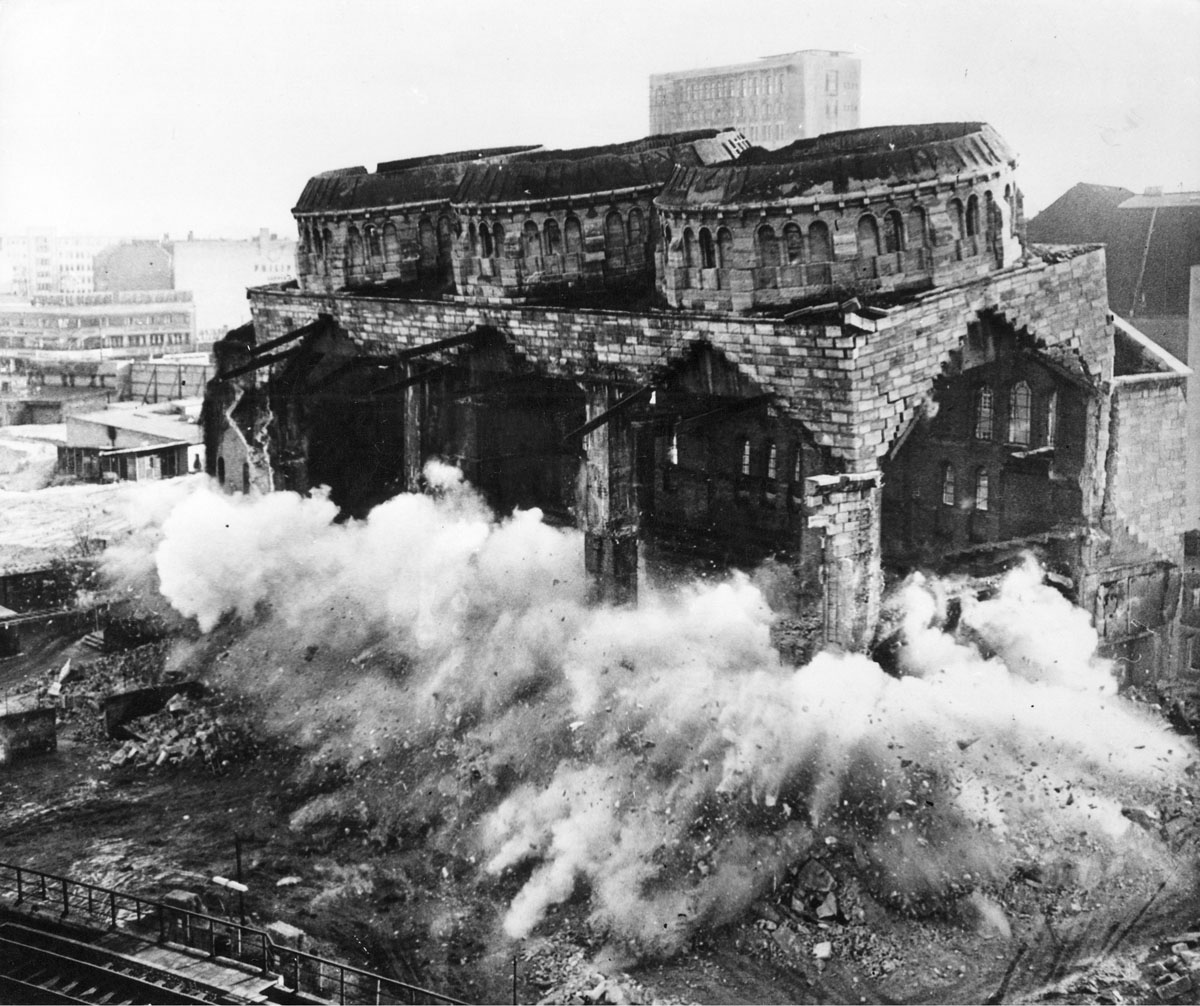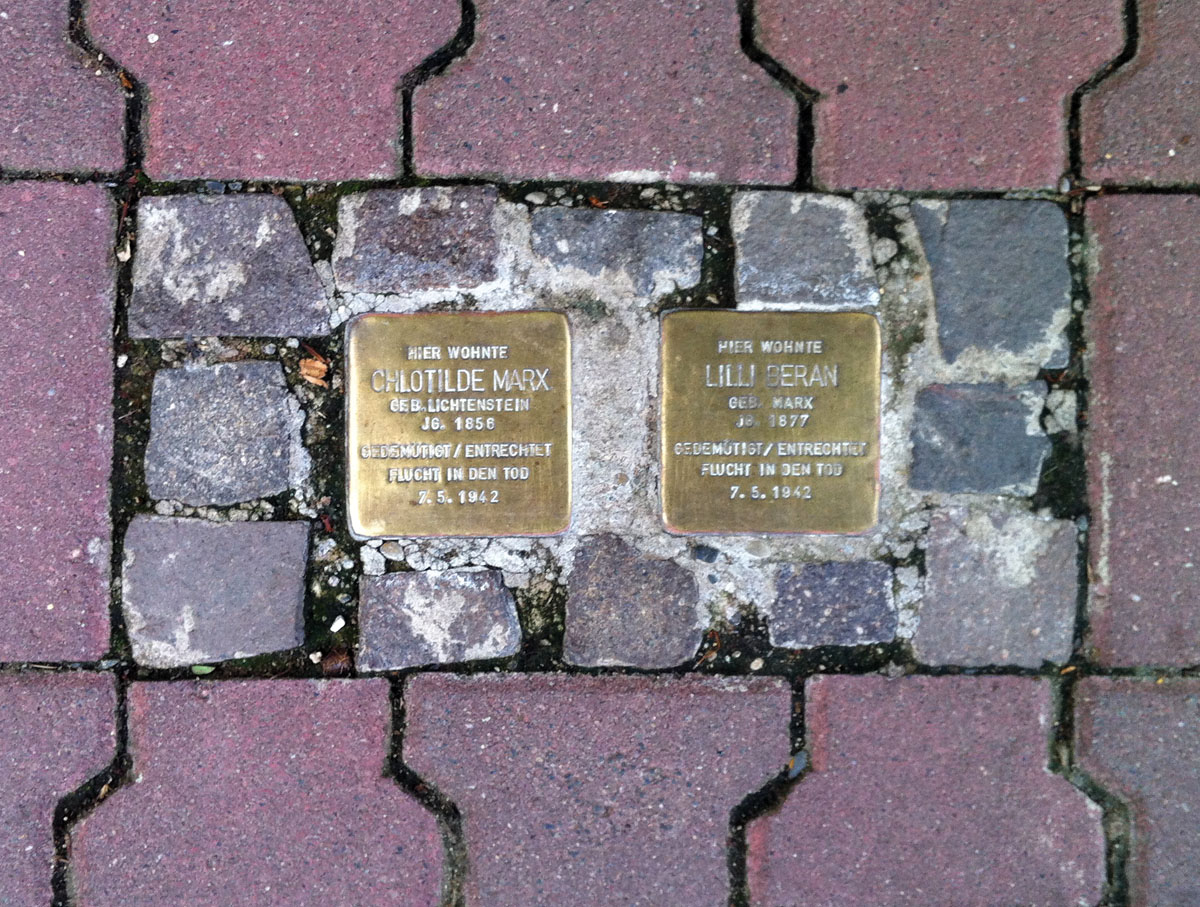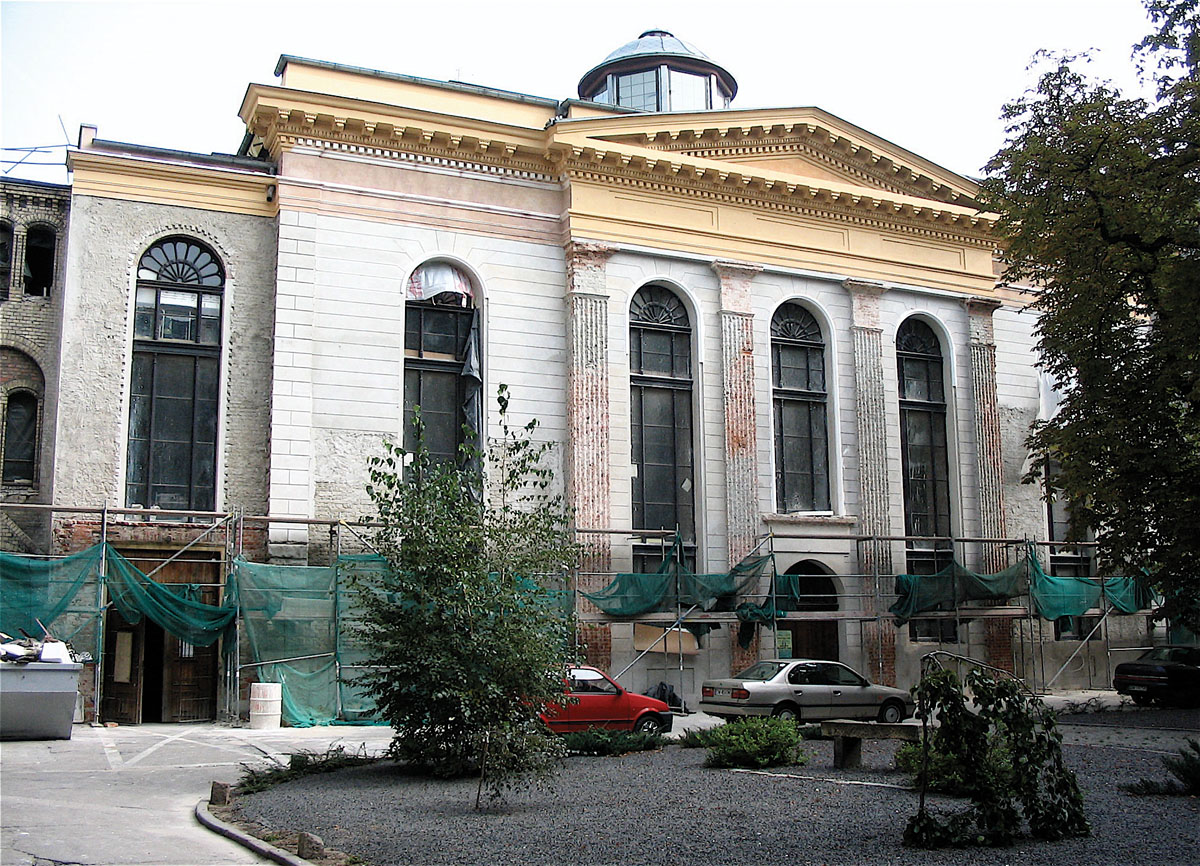sacred places, shattered spaces
Jeff Worley
Michael Meng traces the material legacy of the Holocaust.
 The synagogue on Fasanen Street in West Berlin was one of many that served Germany’s largest Jewish community before the Holocaust. The Nazis destroyed the building’s interior, but its shell survived until demolition in 1958, when this photo was taken. Image courtesy of ullstein bild / The Granger Collection, New York.
The synagogue on Fasanen Street in West Berlin was one of many that served Germany’s largest Jewish community before the Holocaust. The Nazis destroyed the building’s interior, but its shell survived until demolition in 1958, when this photo was taken. Image courtesy of ullstein bild / The Granger Collection, New York.Fist-sized chunks of limestone and cracked brick. Crumbled masonry and leveled columns. Shattered buttresses and pots, toys, and tools. Unfathomable mountains of the stuff in city after city. Shredded books and ash. An occasional charred bicycle.
In many European and Polish cities after World War II, rubble defined the postwar landscape, says Michael Meng in his recently published book, Shattered Spaces: Encountering Jewish Ruins in Postwar Germany and Poland (Harvard University Press, 2011).
And in focusing on these blasted artifacts of war, Meng admits that he writes from a slightly unusual niche as a historian. “Historians devote their careers to studying what happens through time,” says Meng, an assistant professor of history at Clemson University. “I’m interested in exploring the relationship between space and time, how time permeates the spaces around us.”
Shattered Spaces examines the material traces of Jewish life in five cities—Berlin, Warsaw, Potsdam, Essen, and Wroclaw—from 1945 to the present. Meng says he focused on Germany and Poland because they have received international scrutiny like no other European countries for how well or how poorly they have dealt with the legacies of the Holocaust.
His goal in this book was to answer two questions: What happened to Jewish sites after the Holocaust? And how have Germans, Poles, and Jews dealt with these sites since 1945?
“These five cities,” Meng says, “were reduced to debris from aerial bombs, street fighting, and also deliberate acts of violence, especially against Jewish property. The Nazis demolished Jewish sites across Europe, targeting in particular sacred spaces such as synagogues and Jewish cemeteries.” Because they symbolized an enormous genocide, Jewish ruins and spaces in postwar Europe were distinct from other postwar ruins, he adds.
Confronting the rubble
After the war, German and Polish Jewish leaders in what had been reduced to tiny communities began to deal with the issue of what should be done with all these ruins, clearly realizing the enormity of the problem. “Berlin, the epicenter of Hitler’s empire, which caused much of the damage, had seventy-five million cubic meters of rubble after fifty-two thousand tons of aerial bombs and street-by-street fighting in the last throes of the war,” Meng states.
Despite the scale of the work ahead, Jewish leaders knew what ideally should happen: Jewish sites should be preserved. In 1951, a group of American and German rabbis demanded the preservation of synagogues and Jewish cemeteries in the Federal Republic of Germany (FRG). In the Communist East, Jewish leaders made similar appeals to officials in the German Democratic Republic (GDR) and the Polish People’s Republic.
But Jewish organizations could do only so much, Meng explains. Local Jewish leaders had little control over what happened to Jewish sites. In West Germany, East Germany, and Poland, municipal officials owned and controlled most communal property. Despite the similarity of this political reality, Western and Eastern leaders handled the issue of Jewish property very differently.
 Across Germany, small memorials mark places where Jews once lived. The squares are called “stumbling blocks” because people stumble on them in everyday life. Photo by Michael Meng.
Across Germany, small memorials mark places where Jews once lived. The squares are called “stumbling blocks” because people stumble on them in everyday life. Photo by Michael Meng.“Though it’s true Jewish leaders in West Germany thought the ideal solution was to preserve religious ruins, the word ‘ideal’ is key here,” Meng explains. “The amount of property and scale of the problem was so large that widespread preservation simply wasn’t a real option.” And though most Jewish communal property was returned to newly created Jewish successor organizations in West Germany, they often ended up selling it to local governments in order to distribute the profits as quickly as possible to Holocaust survivors.
A distinctly different political solution unfolded in East Germany and Poland, where both Communist parties rejected restitution altogether and seized all Jewish property. This happened for three reasons, Meng says.
“Seizure of Jewish property fell right in line with the Communist parties’ general nationalization of property rights under Communism. These systems also viewed restitution—and this was especially true in East Germany—as a Western, American solution and therefore untenable as the Cold War began. Thirdly, property seizure stemmed from anti-Semitism that not only hadn’t dissipated after the Holocaust but shaped the Communist regimes.”
Meng says that when he started the project, he thought that the main framing of the book would be about a “divided memory,” about differences in postwar handling of Jewish sites rather than similarities. This turned out not to be the case.
“For example, in both East and West, local officials were almost always the ones with the power to decide what to do with Jewish sites, and decisions by local officials often proved disastrous,” Meng says. In the 1950s and 1960s, urban planners, historical preservationists, and local political leaders demolished numerous damaged Jewish sites or allowed them to fall into ruin. In some cases, such as in Warsaw, almost every last fragment of the Jewish past—its streets, shops, and prayer houses—vanished from the urban landscape.
“As Poles and Germans rebuilt their bombed-out cities, towns, and villages, they expelled the traces of the Jewish past,” Meng says. “The few Jewish sites that escaped the wrecking ball gradually decayed by neglect or were turned into movie theaters, storage houses, swimming pools, libraries, and exhibition halls.”
Local officials in Poland, East Germany, and West Germany made deliberate choices about what to rebuild and preserve from the rubble of the war. In his book, Meng points out that when selecting what was culturally valuable, the officials were also making choices about what was not.
“In the 1950s and 1960s, they rarely perceived Jewish sites to be part of the national or local heritage worthy of being maintained. Jewish sites also reflected a deeply discomforting past that few Germans and Poles wanted to deal with in the early postwar decades.”
A Renaissance for Jewish ruins
Not all Jewish sites in the cities Meng researched were destroyed during the war or by the postwar wrecking ball. Cemeteries were the main Jewish spaces that survived urban reconstruction, and two main synagogues in Essen and Wroclaw also survived.
 In Wroclaw, Poland, a Jewish community has been restoring the White Stork, the only synagogue in the city to survive the war. Plans call for a Jewish culture center and museum in the building. Photo by Michael Meng.
In Wroclaw, Poland, a Jewish community has been restoring the White Stork, the only synagogue in the city to survive the war. Plans call for a Jewish culture center and museum in the building. Photo by Michael Meng.“By the late 1970s, a dramatic change started to unfold across this diverse region,” Meng says. “In one of the more remarkable shifts in postwar European history, Germans and Poles went from seeing Jewish sites as worthless rubble to perceiving them as evocative ruins that had to be preserved.” This transformation came about in large part, he says, as younger generations of Poles and Germans grew up in societies with much less hostility toward Jews.
In East Germany and Poland, Jewish sites became national and international issues, as the two Communist parties experienced growing pressure at home and from abroad, primarily from the United States and Israel, to rethink their earlier anti-Jewish policies.
“Preserving Jewish sites became important as both East Germany and Poland started to shift their foreign policy, gradually, to build better relations with the West toward the end of the Cold War,” Meng says, adding that since the collapse of Communism in 1989, interest in Jewish sites has increased at a dizzying rate. Tens of thousands of tourists from the United States, Israel, Canada, and the United Kingdom have traveled to Poland and, increasingly, Germany, in search of the Jewish past.
“People have become drawn to Jewish spaces for a variety of reasons—heritage, growing discussions about the Holocaust, nostalgia for a lost past, and quests for new meaning and identity,” Meng points out. “Jewish sites have become historical monuments, valuable ruins of the past.”
Some archival globe-trotting
Meng says that when he first began thinking of doing research for this book, he knew it would be a time-intensive project.
“I spent three years researching the book and three years writing it, and during that time not a day went by when I didn’t think about Jewish spaces in Germany and Poland—it was constantly on my mind.”
His research was also travel intensive because the documents and histories he needed to read were so spread out. Meng worked in over thirty archives in Germany, Poland, the United States, and Israel.
“One of the things I most enjoy about being a historian is working in archives, those depositories of letters, diaries, memoirs, reports, and memos,” Meng wrote in an email from Germany, where he’s doing archival work for another book. “Historians have only what has been conserved in the archives, and multiple threats exist to conservation—politics, time, war, and water. So historians reconstruct what they can from fragments.”
A number of fellowships, from the Holocaust Educational Foundation, the American Council of Learned Societies, the Graham Foundation, and the Charles H. Revson Foundation, among others, supported his work and travel.
“While my book deals with many differences, it is ultimately about a shared history of Germans and Poles encountering Jewish ruins in quite strikingly similar ways across both sides of the Iron Curtain. The absence of a clear divide along national and political lines surprised me the most. This book complicates the traditional wisdom that Western democracies got things generally right, while the Communist East failed to do so,” Meng says.
Another major point, he says, is how the meanings of space shift over time.
“Contemporary historians typically think of time in linear or circular terms. But in following the thinking of scholars such as Reinhart Koselleck, an intellectual historian, and Stephen Jay Gould, I’m attracted to the notion of geological, layered time as a different way of considering the depth and complexity of the past. Just as geologists study the history of the earth preserved through the strata of its sedimentary rocks, scholars can examine the past through its layers in all their variety of shape, size, density, length, texture, and color.
“This book is one measure of such historical depth, an exploration of the movement from destruction to gradual preservation.”
Michael Meng is an assistant professor of history in the College of Architecture, Arts, and Humanities.


